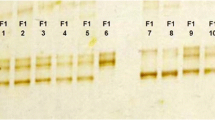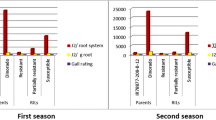Abstract
The use of resistant cultivars is one of the best methods for nematode control and reduction of economic losses caused by these pathogens. Studies of inheritance of nematode resistance in common bean (Phaseolus vulgaris L.) are nonetheless scarce. The present paper reports on the estimation of genetic parameters associated with resistance to the root nematode Meloidogyne incognita race 1 in common beans. Two contrasting bean lines, ‘Aporé’ (P1 = nematode resistant) e ‘Macarrão Rasteiro Conquista’ (P2 = susceptible), and the generations F1 (P1 × P2), F2 (P1 × P2), BC1(P1) = (F1 × P1) and BC1(P2) = (F1 × P2), were assessed 45 days after nematode inoculation, through a scale related to the number of eggs per gram of root tissue. Dominant genetic effects were inferior in magnitude to additive effects, indicating incomplete dominance of nematode resistance. Dominance was in the direction of increased nematode resistance (i.e., lower number of eggs per g root). Resistance to Meloidogyne incognita race 1 in common bean is under control of a single gene locus, with incomplete dominance of the resistance allele present in ‘Aporé’, but modifier genes affecting its expression appear to be present in the susceptible parent ‘Macarrão Rasteiro Conquista’.

Similar content being viewed by others
References
Barrons KC (1940) Root-knot resistance in beans. J Heredity 31:35–38
Blazey DA, Smith PG, Gentile AG, Miyagawa ST (1964) Nematode resistance in common bean. J Heredity 55(1):20–22
Bonetti JIS, Ferraz S (1981) Modificação do método de Hussey and Barker para extração de ovos de Meloidogyne exigua de raízes de cafeeiro. Fitopatologia Brasileira 6(3):553
Campos VP, Campos JR, Silva LDCP, Dutra MR (2001) Manejo de nematoides em hortaliças. In: Silva LHCP, Campos JR, Nojosa GBA (eds) Manejo integrado: doenças e pragas em hortaliças. UFLA, Lavras, pp 125–158
Carneiro GES, Del Peloso MJ, Oliveira CAF, Oliveira E, Silva JFV (2003) Avaliação da resistência de linhagens de feijoeiro (Phaseolus vulgaris L.) a Meloidogyne javanica. In: Congresso Brasileiro de Nematologia, 24. Petrolina/PE. 2003
Charchar JM, Aragão FAZ (2003) Sequência de cultivos no controle de Meloidogyne javanica em campo. Nematologia Brasileira 27(1):81–86
Charchar JM, Horino Y, Moita AW (1995) Reação de cultivares de feijão-vagem em áreas infestadas por Meloidogyne javanica. Horticultura Brasileira 13(1):77
Chen PC, Roberts PA (2003a) Genetic analysis of (a)virulence in Meloidogyne hapla to resistance in bean (Phaseolus vulgaris). Nematology 5(5):687–697
Chen PC, Roberts PA (2003b) Virulence in Meloidogyne hapla differentiated by resistance in commom bean (Phaseolus vulgaris). Nematology 5(1):39–47
Crozzoli R, Greco N, Suarez A, Rivas D (1997) Pathogenicity of the root-knot nematode, Meloidogyne incognita, to cultivars of Phaseolus vulgaris and Vigna unguiculata. Nematropica 27(1):61–67
Cruz CD, Regazzi AJ, Carneiro PCS (2004) Modelos biométricos aplicados ao melhoramento genético. 3.ed. UFV, Viçosa, p 480
Di Vito M, Parisi B, Carboni A, Ranalli P, Catalano F (2005) Response of common bean (Phaseolus vulgaris L.) to Italian populations of four species of Meloidogyne. Nematologia Mediterrânea 33(1):19–23
Ferreira S, Gomes LAA, Maluf WR, Campos VP, de Carvalho Filho JLS, Santos DC (2010) Resistance of common bean and snap bean cultivars to root-knot nematodes. HortScience 45(2):320–322
Freitas LC, Ramalho MAP, Silva FB (2002) Controle genético da resistência aos nematoides de galhas em feijoeiro. In: Congresso Nacional de Pesquisa de Feijão, 7. Viçosa/MG
Hadisoeganda WW, Sasser JN (1982) Resistance of tomato, bean, southern pea, and garden pea cultivars to root-knot nematodes based on host suitability. Plant Dis 66(2):145–150
Hartmann RW (1968) Manoa Wonder, new root-knot nematode resistant pole bean. Hawaii Agricultural Extension–Circular 67:5–10
Hartmann RW (1971) Inheritance of a resistance to root-knot nematodes (Meloidogyne incognita) in beans (Phaseolus vulgaris). Journal of American Society for Horticultural Science 96(3):344–347
Hussey RS, Barker KR (1973) A comparison of methods collecting inocula of Meloidogyne spp. including a new technique. Plant Disease. Reporter 57(12):1025–1028
Mather K, Jinks JL (1974) Genética biométrica, 2nd edn. Cornell University Press, Ithaca, p 382
Mullin BA, Abawi GS, Pastor-Corrales MA (1991) Modification of resistance expression of Phaseolus vulgaris to Meloidogyne incognita by elevated soil temperatures. Journal of Nematology 23(2):182–187
Omwega CO, Roberts PA (1992) Inheritance of resistance to Meloidogyne spp in common bean and the genetic basis of this sensibility to temperate. Theoretical and Applied Genetics 83:720–726
Omwega CO, Thomason IJ, Roberts PA, Waines J (1989) Identification of new sources of resistance to root-knot nematodes in Phaseolus. Crop Sci 29:1463–1468
Omwega CO, Thomason IJ, Roberts PA (1990) A single dominant gene in common bean conferring resistance to three root-knot nematode species. Phytopathology 80(8):745–748
Pedrosa EMR, Moura RM, Silva EG (2000) Respostas de genótipos de Phaseolus vulgaris à meloidoginose e alguns mecanismos envolvidos na reação. Fitopatologia Brasileira 25(2):190–196
Peixoto N, Morais EA, Monteiro JD, Thung MDT (2001) Seleção de linhagens de feijão-vagem de crescimento indeterminado para cultivo no estado de Goiás. Horticultura Brasileira 19:85–88
Silbernagel MJ, Janssen W, Davis JHC, Oca GM (1991) Snap bean production in the tropics: implications for genetic improvement. In: Schoonhoven A van, Voysest O. Common beans: research for crop improvement. CIAT, 980 pp. UK: Redwood Press Ltd, Melksham, Wiltshire. pp 835–863
Silva FB, Ramalho MAP, Abreu AFB (2005) Genetic control of Meloidogyne incognita resistance in common bean. Annual Report of the Bean Improvement Cooperative 48:64–65
Silva RV, Oliveira RDL, Pereira AA, Sêni DJ (2007) Respostas de genótipos de Coffea spp. a diferentes populações de Meloidogyne exigua. Fitopatolgia Brasileira 32(3):205–212
Southey JF (1970) Laboratory methods for work with plant and soil nematodes, 5th edn. Ministry of Agriculture and Food, London 148 pp
Statistical analysis system. SAS user’s guide statistics (1999) Version 8. SAS Institute Inc., Cary, p 956
Wyatt JE, Fassuliotis G, Johnson AW, Hoffman JC, Deakin JR (1980) B4715 root-knot nematode resistant snap bean breeding line. HortScience 15:530
Acknowledgments
The authors are indebted to the agencies and companies that funded or supported this study: Fundação de Amparo à Pesquisa do Estado de Minas Gerais (FAPEMIG), Conselho Nacional de Desenvolvimento Científico e Tecnológico (CNPq), Coordenação de Aperfeiçoamento de Pessoal de Nível Superior (CAPES), Universidade Federal de Lavras (UFLA), Fundação de Apoio ao Ensino Pesquisa e Extensão (FAEPE) and HortiAgro Sementes Ltda.
Author information
Authors and Affiliations
Corresponding author
Rights and permissions
About this article
Cite this article
Ferreira, S., Gomes, L.A.A., Maluf, W.R. et al. Genetic control of resistance to Meloidogyne incognita race 1 in the Brazilian common bean (Phaseolus vulgaris L.) cv. Aporé. Euphytica 186, 867–873 (2012). https://doi.org/10.1007/s10681-012-0655-7
Received:
Accepted:
Published:
Issue Date:
DOI: https://doi.org/10.1007/s10681-012-0655-7




